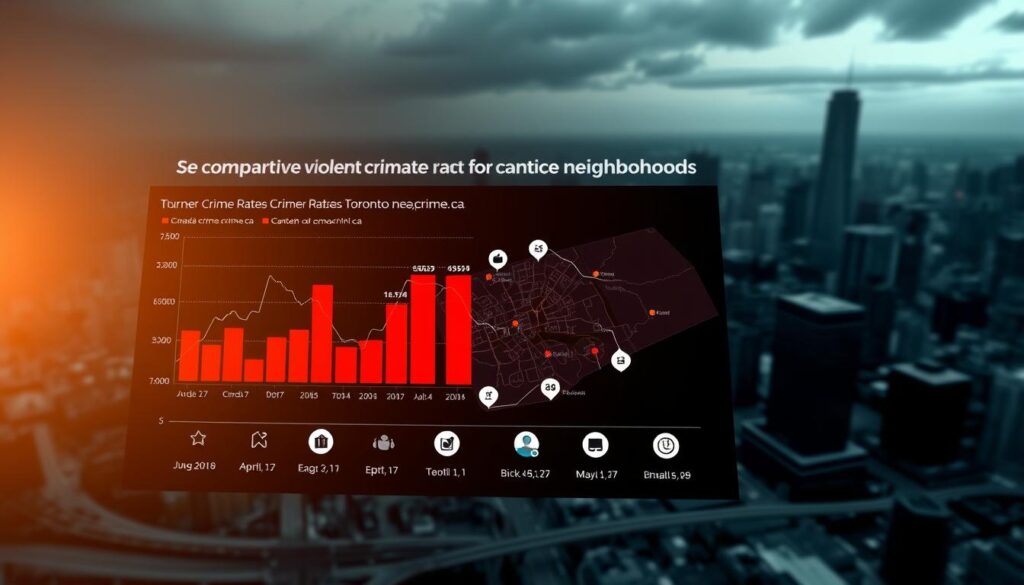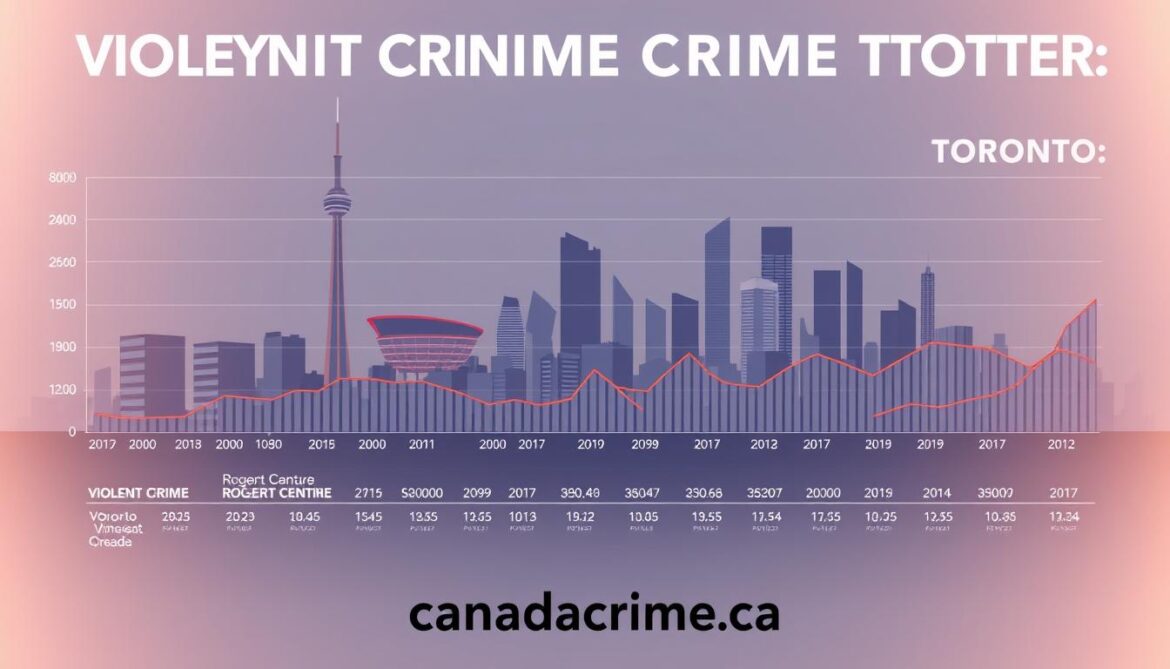Toronto, once a stalwart in the top 10 of the Global Liveability Index, slipped to 12th place in 2024, according to The Economist Intelligence Unit (EIU). Despite this drop, the city remains one of the safest major metropolitan areas globally, ranking 8th in personal security.
With a crime rate of 286.9 offences per 100,000 residents in 2023, Toronto stands out as Canada’s safest city. The violent crime rate Toronto has shown a slight increase over the past year, causing concern among residents and local authorities.
The city’s crime landscape is complex, with fluctuations in crime statistics that warrant a detailed examination. Understanding Toronto’s crime trends requires a nuanced analysis of the Canadian Crime Code and how offenses are classified and reported.
This analysis will provide insights into Toronto’s current safety status, historical crime trends, and comparisons with other major cities, offering a comprehensive view of the city’s crime information.
Current State of Violent Crime in Toronto
According to the Toronto Police Service’s Major Crime Indicators, the city’s crime rate in 2024 is characterized by both declines and increases in various crime categories. Despite some concerning trends, Toronto remains one of the safer major metropolitan areas in North America.

Toronto’s Safety Ranking in 2024
Toronto’s current safety ranking in 2024 shows the city maintaining its position as one of the safer major cities. According to the 2024 Global Liveability Index, Toronto ranks 8th worldwide for personal security.
The city’s crime rate stands at 286.9 offenses per 100,000 residents, positioning it as the safest major city in Canada based on 2023 data.
Key Highlights:
- Toronto is ranked 8th globally for personal security.
- The city has a crime rate of 286.9 offenses per 100,000 residents.
Major Crime Indicators for 2024
The latest Major Crime Indicators tracked by the Toronto Police Service reveal a 1.3% reduction in major crimes investigated compared to 2023. The statistics show that as of 2024, there have been 37,320 major crimes reported, down from 39,019 during the same period in 2023.
The top ten major offenses reported include:
- Assault — 18,818 (up 5.7%).
- Auto Theft — 7,045 (down 21.3%).
- Breaking and Entering — 5,030 (down 3.6%).
- Robbery — 2,312 (up 5.7%).
- Sexual Violations — 2,630 (up 13.1%).
While certain property crimes like auto theft have decreased significantly, there are concerning increases in sexual violations and robbery, suggesting a need for targeted intervention in these areas.
Violent Crime Rate Toronto: Historical Trends
Understanding Toronto’s violent crime trends requires examining the historical context and significant events that have shaped the city’s crime landscape. The city’s violent crime rate has experienced significant fluctuations over the years, influenced by a range of social, economic, and policy factors.
Crime Rate Fluctuations Since 2000
Since 2000, Toronto has seen notable peaks and valleys in its violent crime rate. The city’s crime statistics have been influenced by broader urban safety factors, including socioeconomic conditions and law enforcement strategies.
In the early 2000s, Toronto faced a concerning rise in violent crimes, culminating in the infamous “Year of the Gun” in 2005.

The period following 2005 saw the implementation of various crime prevention strategies, which contributed to a decline in violent crime rates. By 2011, Toronto recorded its lowest homicide total since 1986, with a rate of 2.0 per 100,000 people, close to the national average.
The “Year of the Gun” and Its Aftermath
The “Year of the Gun” in 2005 was a pivotal moment in Toronto’s crime history, with gun-related homicides reaching a record 52 out of 80 total murders. This crisis prompted significant policy changes and community initiatives aimed at addressing the root causes of violence. The aftermath saw a steady decline in violent crime rates, with a relatively stable period between 2009 and 2015.
However, the homicide rate began to rise again in 2016, jumping to 75 homicides, and spiked further in 2018 with 98 homicides, partially influenced by the Toronto van attack that claimed 10 lives.
This increase highlights the ongoing challenges in maintaining low crime rates and the need for continued efforts in crime prevention.
The historical data on Toronto’s violent crime rate per 100,000 people shows that while the city has generally had lower rates compared to similar US cities, there have been instances where it exceeded rates in other Canadian metropolitan areas. The fluctuations in crime rates underscore the importance of adaptive and responsive crime prevention strategies.
Toronto vs. Other Canadian Cities: Crime Rate Comparison
When evaluating the safety of Canadian cities, Toronto’s crime statistics provide valuable insights. Toronto, being Canada’s largest metropolitan area, is often a point of reference for crime rate comparisons.

Toronto’s Position in National Crime Rankings
According to a 2024 report by CTV News, Toronto ranks as the safest city in Canada, with a crime rate of 286.9 offenses per 100,000 residents, based on 2023 data. This ranking considers various crimes such as arson, robbery, impaired driving, and burglary.
Toronto outperformed other cities like Quebec City, which had 301 offenses per 100,000 people, and Ottawa-Gatineau, QC, which ranked third.
The city’s position in national crime rankings has fluctuated over the years. Notably, in 2018, Toronto experienced a spike in homicides, temporarily placing it at the top of the homicide rate rankings among major Canadian cities.
Crime Severity Index Across Major Canadian Cities
The Crime Severity Index (CSI), which weights crimes by their seriousness, places Toronto among the safer major Canadian cities. Although not at the top of the rankings, Toronto’s CSI score indicates a relatively low level of serious crime compared to other large urban centers.
Other Canadian cities with notably low crime rates include Barrie, Trois-Rivières, Saguenay, and Hamilton. These cities demonstrate regional variations in public safety across Canada, with factors such as population density, economic conditions, and social services availability contributing to the differences in crime rates.
Toronto vs. US Cities: Surprising Crime Statistics
Toronto’s crime rates, when compared to US metropolitan areas, present some surprising contrasts. A recent study by the Fraser Institute provides valuable insights into these differences, examining crime rates in large urban areas with populations over 100,000 people.
The study reveals that Toronto’s property crime rate per person is approximately 40% higher than New York City’s. This finding challenges the common perception that Canadian cities are universally safer than their US counterparts. Property crimes, including burglary, theft, and motor vehicle theft, are more prevalent in Toronto than in several major US cities.
Property Crime Comparison with New York and Other US Cities
According to the Fraser Institute’s analysis of data from 2019 to 2022, Toronto, Hamilton, and Windsor all ranked higher for property crime than New York, Detroit, and several Michigan cities. This indicates a different pattern in property crime rates between Canadian and US cities.

Violent Crime Rate Differences Between Toronto and US Metropolitan Areas
Despite higher property crime rates, Toronto maintains significantly lower violent crime rates per 100,000 people compared to most major US metropolitan areas.
For instance, Toronto’s homicide rate has fluctuated between 2.1 and 3.8 per 100,000 people over the past decade, substantially lower than cities like Atlanta (19.0), Chicago (18.5), and Boston (9.0).
As emphasized by the Fraser Institute’s study,
“These comparative statistics highlight the importance of distinguishing between different types of criminal activity when assessing overall urban safety.”
This distinction is crucial for a nuanced understanding of crime in urban areas.
Toronto Crime Rate by Neighbourhood
A closer look at Toronto’s neighborhoods reveals a diverse crime landscape, with areas of concern and areas of relative safety. The city’s crime rate varies significantly across different neighborhoods, creating a complex picture that requires nuanced understanding and targeted prevention strategies.

Areas with the Highest Crime Rates
According to the Toronto Police Service’s Major Crime Indicators for 2024, the West Humber Clairville neighborhood has experienced the highest number of major crimes year to date, with 1,570 incidents, representing a 30.5% increase over the previous year.
Other neighborhoods with high crime rates include Downtown Yonge East, Moss Park, and York University Heights, with 705, 695, and 690 incidents, respectively.
These areas continue to experience high crime volumes, though with more modest year-over-year increases. For instance, Downtown Yonge East saw a 2.5% increase, while Moss Park and York University Heights experienced 1.5% and 1.2% increases, respectively.
Neighbourhoods Experiencing Significant Changes
Some Toronto neighborhoods have seen dramatic changes in their crime rates. Princess-Rosethorn has witnessed a 215.3% increase in major crimes, followed by Kingsway South with a 140.7% increase, and Milliken with a 110.5% increase. These significant increases highlight the need for targeted crime prevention initiatives in these areas.
In contrast, neighborhoods like Woodbine-Lumsden have reported a 35% decrease in major crimes, with only 50 incidents year to date. The government and Toronto Police Service have implemented neighborhood-specific crime prevention initiatives, focusing on community engagement and addressing environmental factors that contribute to criminal activity.
By understanding the crime trends in specific Toronto neighborhoods, residents and law enforcement can work together to create safer communities. The variability in crime rates across the city underscores the importance of tailored approaches to crime prevention.
Understanding the Canadian Crime Code
The Canadian Crime Code is a comprehensive legal framework that governs criminal offenses in Canada. It provides specific provisions for various types of crimes, including violent crimes, which are categorized and prosecuted according to their severity.

Classification of Violent Crimes in Canada
Under Canadian law, violent crimes are classified into several major categories, including homicide, assault, sexual assault, robbery, and other offenses against the person. Each of these categories has varying degrees of severity, which are taken into account during prosecution. For instance, homicide statistics in Canada have shown significant fluctuations over time.
In 2023, there were 778 homicides nationwide, with 123 occurring in Toronto alone.
The classification of these crimes is crucial for understanding crime statistics and for the effective administration of justice. The Uniform Crime Reporting (UCR) Survey, managed by Statistics Canada, collects data from police services representing 99% of the Canadian population. This standardized methodology allows for consistent year-over-year comparisons.
How Crime Statistics Are Recorded and Reported
Crime statistics in Canada are recorded based on the UCR Survey. The Crime Severity Index (CSI), introduced in 2009, provides a more nuanced measure of crime by weighting offenses according to their seriousness, as determined by actual sentencing data. This approach helps in understanding the impact of different types of crimes on society.
Understanding how crime statistics are recorded and reported is essential for accurate interpretation. Methodological differences can significantly impact comparative analyses between different time periods or jurisdictions. For example, Toronto’s homicide rate has fluctuated, with 123 homicides in 2023 out of 778 nationwide, compared to 145 in 2018 out of 665 nationwide.
The government agency responsible for collecting and analyzing crime data is Statistics Canada. By maintaining standardized methodologies, Statistics Canada enables the public and policymakers to make informed decisions based on reliable data and trends over time.
Top Violent Offences in Toronto and Their Trends
Toronto’s violent crime rate is influenced by various factors, including the prevalence of specific types of violent offenses. The Toronto Police Service’s data for 2024 to date provides insights into the trends and statistics of these crimes.
The data indicates that assault remains the most prevalent violent offense, with 18,818 incidents reported, representing a 5.7% increase over the previous year. More serious categories of assault, such as assault with a weapon (4,489 cases) and assault causing bodily harm (1,001 cases), show concerning trends.
Assault and Robbery Statistics
Robbery incidents have also seen a 5.7% increase, with 2,312 cases reported, including 988 incidents involving weapons. According to the Fraser Institute’s analysis, Toronto’s assault rates per 100,000 people remain significantly lower than comparable US metropolitan areas.
| Crime Category | Incidents Reported | Percentage Change |
|---|---|---|
| Assault | 18,818 | +5.7% |
| Robbery | 2,312 | +5.7% |
| Sexual Violations | 2,630 | +13.1% |
Homicide Trends in Toronto
Homicide trends in Toronto have fluctuated over the past decade, with rates varying between 2.1 and 3.8 per 100,000 people. This positions Toronto favorably compared to US cities like Chicago (18.5) and Atlanta (19.0).

The comparison with US cities highlights Toronto’s relatively low homicide rate, despite the fluctuations. The data from the Toronto Police Service and analyses by the Fraser Institute provide a comprehensive view of Toronto’s crime landscape.
Conclusion: The Future of Toronto’s Crime Landscape
With crime rates in some Canadian cities on the rise, Toronto’s experience offers valuable insights into effective crime prevention strategies. According to recent data, Toronto remains one of the safer major cities in Canada and North America. The city’s violent crime rate per 100,000 people is lower than historical peaks and significantly below comparable United States metropolitan areas.
Toronto’s crime landscape is evolving due to demographic shifts, economic factors, and the effectiveness of prevention strategies. The crime trends indicate a need for continued attention to property crime rates, which are higher relative to some US cities like New York, as highlighted by a Fraser Institute study. This suggests a need for targeted strategies addressing theft, burglary, and other property offenses.
Future crime trends will be influenced by urbanization, income inequality, and community-based prevention programs. Data-driven approaches to crime prevention, including predictive policing and targeted resource allocation, will be crucial.
Continued investment in addressing root causes of crime, such as poverty and mental health services, is essential for maintaining Toronto’s safety advantage.
As Toronto grows and diversifies, its crime prevention strategies must adapt to changing demographics and emerging crime patterns. By doing so, the city can maintain its reputation as one of North America’s safer major urban centers.

